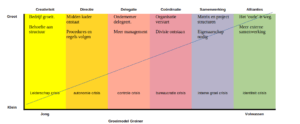Greiner growth model for organizations
Greiner growth model shows how all organizations change during their growth and development. If we look at a startup and then a large corporation, we see how drastic the changes can be. This includes management focus, management style, organizational structure, strategy, etc.
Phases
.
These changes are difficult to follow when you are close to the fire. Yet the organization changes as Greiner growth model shows. Often organically but also with shocks when far-reaching policy decisions are made. With these evolutionary and transformational changes, a different type of leadership is also required each time.
This is where maturity models come into play. Maturity models are clear frameworks that measure an organization’s maturity across a number of disciplines or functions. They help identify the specific areas that need improvement to reach the next level of maturity. Most maturity models qualitatively assess people/culture, processes/structures, and objects/technology.
Dimensions
.
In capturing the maturity of a growing organization, there are 5 dimensions within Greiner growth model:
1. Age of the organization
2. Size of the organization
3. Stages of Development
4. Stages of “Revolution”
5. Industry Growth
Greiner groei model
1. Age of the organization
The most obvious and essential dimension for any maturity model is an organization’s age (shown on the chart as the horizontal axis). Management problems and principles are rooted in specific time periods of the organization. This is illustrated by the fact that specific organizational structures and functions are not maintained throughout the lifespan. The passage of time also contributes to the institutionalization of management attitudes. As these attitudes become rigid and eventually outdated, employee behavior becomes more predictable and more difficult to change.
2. Size of the organization
The second dimension is the size of the organization (represented by the vertical axis of the diagram). Organizational problems and solutions tend to change significantly as the number of employees and the volume of sales increase. Coordination and communication problems are increasing, new jobs are emerging, the number of management levels is increasing and jobs are becoming more intertwined.
3. Stages of Development
Evolution is a prolonged period of growth in which there is no major upheaval in organizational practices. Each evolutionary period is characterized by the dominant management style used to achieve growth. Most growing organizations don’t extend two years and then contract one year. Instead, those who survive a crisis usually enjoy four to eight years of uninterrupted growth without a major economic setback or major internal disruption. As a company moves through its growth stages, each evolutionary period creates its own “revolution”.
4. Stages of “Revolution”
Revolution is a period of significant turmoil in the life of the organization. Each revolutionary period is characterized by the dominant management problem that must be solved before growth can continue. Traditional management practices that were appropriate for a smaller size and an earlier era no longer work and are being scrutinized by top management and lower managers. During times of crisis, organizations unable to abandon their past practices and make major organizational changes are likely to go bankrupt or see their growth flatten.
5. Industry Growth Rate
The speed at which an organization goes through phases of evolution and revolution is closely related to the market environment of its industry. For example, a company in a fast-growing market will need to add employees quickly. In fast-growing industries, evolution periods are usually relatively short, while longer evolution periods occur in mature or slow-growing industries.
Also, evolutions may be prolonged and revolutions delayed when profits come easily. Thus, companies that make serious mistakes in a prosperous industry may still look good on their financials. This allows them to buy time before a crisis forces changes in business operations.
Maturity model Deloitte
Deloitte’s maturity model has a similar structure for the growth and development of organisations. The model has 4 phases in the development of organizations:
Pioneer phase:
Initial vision and objectives as the most important guideline,
Strong Informal collaboration, which is possible due to limited organization size.
Process phase:
Professionalization of the organization: process agreements and procedures are recorded per department or team,
Within the ‘island organisation’, each unit works with its own systems and procedures,
Cooperation within the units is structured, cooperation between units on an ad hoc basis.
System phase :
Uniform processes, procedures and systems,
Information exchange and close cooperation between different organizational units,
Jointly formulated strategy and organizational objectives are the basis for cooperation.
Network phase :
Partners from the value chain in the network are increasingly involved,
Collaboration on strategy formation, information exchange and value chain management,
systems. Processes and procedures are coordinated both internally and externally.
Synchronizing and supervising the different phases is important to keep the performance of the organizations up to scratch and stable. Major disruptions in performance as a result of growth [pains] can seriously damage an organization’s market development. Shrinkage is then lurking. It deserves mention that an organization does not have to grow in order to perform well. The structure of the organization is largely determined by its size. That size and layout is significant for the performance of the organization. Big is not necessarily better.




